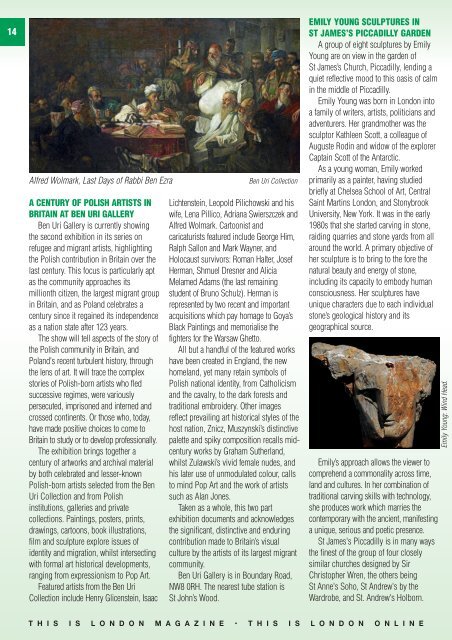TIL 7 July 2017
You also want an ePaper? Increase the reach of your titles
YUMPU automatically turns print PDFs into web optimized ePapers that Google loves.
14<br />
Alfred Wolmark, Last Days of Rabbi Ben Ezra<br />
A CENTURY OF POLISH ARTISTS IN<br />
BRITAIN AT BEN URI GALLERY<br />
Ben Uri Gallery is currently showing<br />
the second exhibition in its series on<br />
refugee and migrant artists, highlighting<br />
the Polish contribution in Britain over the<br />
last century. This focus is particularly apt<br />
as the community approaches its<br />
millionth citizen, the largest migrant group<br />
in Britain, and as Poland celebrates a<br />
century since it regained its independence<br />
as a nation state after 123 years.<br />
The show will tell aspects of the story of<br />
the Polish community in Britain, and<br />
Poland's recent turbulent history, through<br />
the lens of art. It will trace the complex<br />
stories of Polish-born artists who fled<br />
successive regimes, were variously<br />
persecuted, imprisoned and interned and<br />
crossed continents. Or those who, today,<br />
have made positive choices to come to<br />
Britain to study or to develop professionally.<br />
The exhibition brings together a<br />
century of artworks and archival material<br />
by both celebrated and lesser-known<br />
Polish-born artists selected from the Ben<br />
Uri Collection and from Polish<br />
institutions, galleries and private<br />
collections. Paintings, posters, prints,<br />
drawings, cartoons, book illustrations,<br />
film and sculpture explore issues of<br />
identity and migration, whilst intersecting<br />
with formal art historical developments,<br />
ranging from expressionism to Pop Art.<br />
Featured artists from the Ben Uri<br />
Collection include Henry Glicenstein, Isaac<br />
Ben Uri Collection<br />
Lichtenstein, Leopold Pilichowski and his<br />
wife, Lena Pillico, Adriana Swierszczek and<br />
Alfred Wolmark. Cartoonist and<br />
caricaturists featured include George Him,<br />
Ralph Sallon and Mark Wayner, and<br />
Holocaust survivors: Roman Halter, Josef<br />
Herman, Shmuel Dresner and Alicia<br />
Melamed Adams (the last remaining<br />
student of Bruno Schulz). Herman is<br />
represented by two recent and important<br />
acquisitions which pay homage to Goya’s<br />
Black Paintings and memorialise the<br />
fighters for the Warsaw Ghetto.<br />
All but a handful of the featured works<br />
have been created in England, the new<br />
homeland, yet many retain symbols of<br />
Polish national identity, from Catholicism<br />
and the cavalry, to the dark forests and<br />
traditional embroidery. Other images<br />
reflect prevailing art historical styles of the<br />
host nation, Znicz, Muszynski’s distinctive<br />
palette and spiky composition recalls midcentury<br />
works by Graham Sutherland,<br />
whilst Zulawski’s vivid female nudes, and<br />
his later use of unmodulated colour, calls<br />
to mind Pop Art and the work of artists<br />
such as Alan Jones.<br />
Taken as a whole, this two part<br />
exhibition documents and acknowledges<br />
the significant, distinctive and enduring<br />
contribution made to Britain’s visual<br />
culture by the artists of its largest migrant<br />
community.<br />
Ben Uri Gallery is in Boundary Road,<br />
NW8 0RH. The nearest tube station is<br />
St John’s Wood.<br />
EMILY YOUNG SCULPTURES IN<br />
ST JAMES’S PICCADILLY GARDEN<br />
A group of eight sculptures by Emily<br />
Young are on view in the garden of<br />
St James’s Church, Piccadilly, lending a<br />
quiet reflective mood to this oasis of calm<br />
in the middle of Piccadilly.<br />
Emily Young was born in London into<br />
a family of writers, artists, politicians and<br />
adventurers. Her grandmother was the<br />
sculptor Kathleen Scott, a colleague of<br />
Auguste Rodin and widow of the explorer<br />
Captain Scott of the Antarctic.<br />
As a young woman, Emily worked<br />
primarily as a painter, having studied<br />
briefly at Chelsea School of Art, Central<br />
Saint Martins London, and Stonybrook<br />
University, New York. It was in the early<br />
1980s that she started carving in stone,<br />
raiding quarries and stone yards from all<br />
around the world. A primary objective of<br />
her sculpture is to bring to the fore the<br />
natural beauty and energy of stone,<br />
including its capacity to embody human<br />
consciousness. Her sculptures have<br />
unique characters due to each individual<br />
stone’s geological history and its<br />
geographical source.<br />
Emily’s approach allows the viewer to<br />
comprehend a commonality across time,<br />
land and cultures. In her combination of<br />
traditional carving skills with technology,<br />
she produces work which marries the<br />
contemporary with the ancient, manifesting<br />
a unique, serious and poetic presence.<br />
St James's Piccadilly is in many ways<br />
the finest of the group of four closely<br />
similar churches designed by Sir<br />
Christopher Wren, the others being<br />
St Anne's Soho, St Andrew's by the<br />
Wardrobe, and St. Andrew's Holborn.<br />
Emily Young: Wind Head.<br />
t h i s i s l o n d o n m a g a z i n e • t h i s i s l o n d o n o n l i n e

















